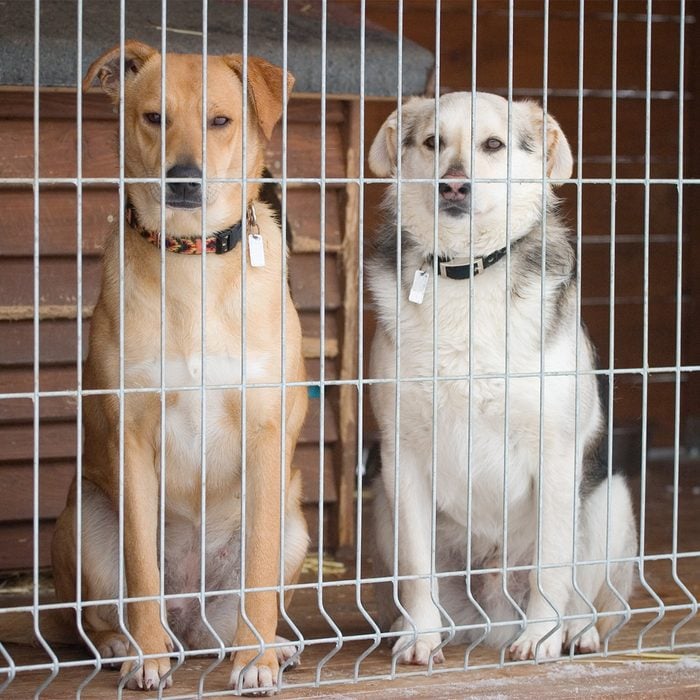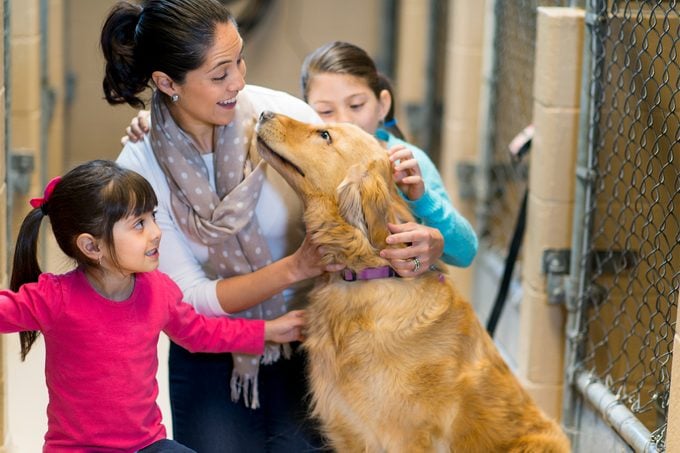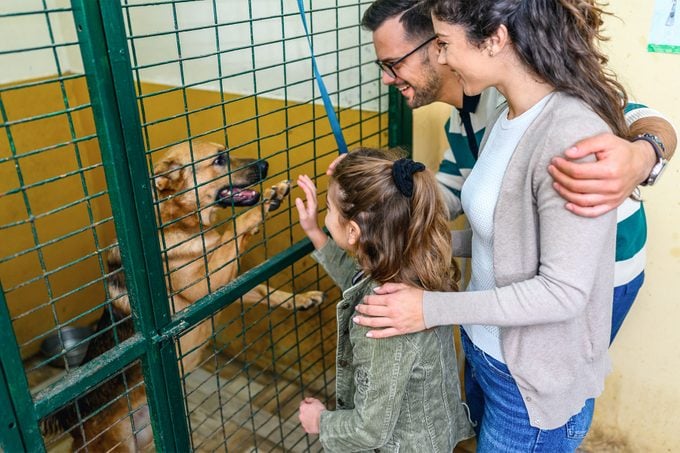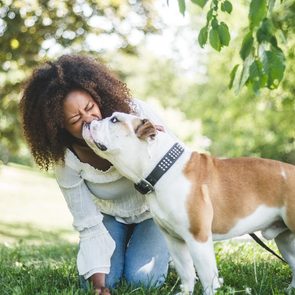13 Things Shelter Dogs Wish You Knew
Updated: Apr. 17, 2024

Here's what to know about shelter dogs before taking them home as your new furry BFF
When you make the decision to adopt a shelter dog, it’s hard to contain your excitement. You’re anxious to visit the shelter, scoop up your new pup, and smother him with all the love and attention he deserves. That shelter dog also longs to be in a forever home with you, but it’s not always quite that simple. Embarking on this second chance of rehoming may be more of a process for your new pet than you realize. That’s why we’re sharing what to know about shelter dogs (and what they wish you knew about them too!).
Reader’s Digest spoke with various canine experts to give you the best insight on what to know before adopting your furry friend. Derek Panfil, the senior vice president of merchandising at Pet Supplies Plus; Lindsay Hamrick, the companion animals public policy director for the Humane Society of the United States; and Bernice Clifford, the director of behavior and training at the Animal Farm Foundation, are only a few of the experts we connected with for this piece.
So, read on to learn just how your shelter dog might be feeling before you bring them home.
Get Reader’s Digest’s Read Up newsletter for more pet insight, fun facts, humor, cleaning, travel and tech all week long.
About the experts
|
I might be super excited to see you
Keep in mind that I may have been in a kennel for a long time, and anything that I see or experience is going to be new and exciting! Hey, did I mention that I’m excited?!
While some dogs may be timid when you visit the shelter, others may jump up on you or bark excessively. But don’t let a dog’s unbridled enthusiasm scare you off. According to Panfil, it usually takes at least two weeks for a dog to decompress and get accustomed to a new home. After that, pet parents can slowly incorporate new lessons and further teach expected behavior. “With proper positive training and a little time and patience, dogs can learn to remain calm in exciting situations,” says Panfil.
I might be a little scared
Adoption events can be chaotic in general, so think about how loud and scary it can be for dogs like me.
That little cutie cowering in the corner of his crate wants a forever home, but he’s too scared to show you. Just like people, it can take a little time for dogs to warm up. “It doesn’t mean the dog isn’t social or that it wouldn’t make a great family dog,” says Panfil. If possible, get away from the commotion and find a quiet area to spend time with the dog, or take him on a short walk. Keep in mind that it may take more than one meet and greet for the dog to feel safe and secure with you. Panfil says sometimes that means taking the dog home with you and giving him a few weeks to adjust.
We want to stay with our pet siblings
The shelter has kept us together because it’s all we have left of our previous life.
People tend to surrender dogs and their “siblings” to shelters for a few common reasons. They include unexpected circumstances like the death of a pet parent, a loss of income or not being able to find a home that allowed dogs. You might not have planned to adopt two dogs, but you may want to consider opening your home to a bonded pair. This special situation also offers some wonderful advantages. “You’re not only preventing the dogs from losing another family member—you’re also getting two dogs who already get along and can help each other ease the transition to a new home,” says Hamrick.
The shelter might not know my breed
I’m an individual, no matter what breed or mixed breed I am.
Some animal shelters label dogs, but it’s only an educated guess. Even veterinarians can guess the wrong breed. “Another issue is that ‘pit bull‘ is not actually a breed and has become a shelter catchall for many dogs,” says Clifford. Remember that a dog’s personality is more important than a label. To figure that out, spend time with the dog and include all the family members before making a decision. If the previous family surrendered the dog, ask questions about his behavior and lifestyle. “A great predictor of future behavior is previous behavior in a similar situation,” says Clifford. All dogs, just like all people, are individuals.
I might need time to adjust to your cat or kids
Just because I’ve never been around kids or other pets, it doesn’t mean that I won’t love them—in time.
When an animal’s history is known, the shelter will clearly state whether that dog would prefer to be the only pet or live without young children. For the times when past experiences aren’t known, bring the whole family for a visit, if possible. While this doesn’t guarantee behavior once you get home, it does give you an opportunity to observe how the dog and kids interact with one another.
And once your new dog is home, take it slow. “Teach children how to interact and be respectful of their new pet while everyone gets comfortable with each other,” says Clifford. “Set up baby gates and use a crate in the beginning when your new family member cannot be supervised.” Do the same with furry siblings. “Existing pets and new pets need time to adjust to each other,” explains Clifford. “When not supervising, separate the pets until everyone is comfortable with each other.”
I would love a second chance at happiness

My life hasn’t been a happy one. I’ve been neglected and abused, but with a little patience and compassion, I could be a loyal companion for life.
Some shelter dogs have been rescued from known abuse and neglect. Other dogs arrive at shelters as strays, so it’s impossible to know their background. What is known: These dogs want a forever home where they can be loved and give love. “If you’re adopting a shy or fearful dog, it’s important to take things slowly and let them go at their own pace,” says Krista Maloney, a spokesperson for the San Francisco SPCA. “Don’t force them into situations that they find scary, which can just make matters worse. Build confidence through environmental enrichment, practicing new skills and positive experiences.”
I may be on the older side, but I’ve still got a lot to offer
I know, I know—puppies are irresistibly cute. But you won’t have to puppy-proof your house if you take me home, and I won’t eat your slippers!
“Older dogs are slower and need less exercise and more love,” says Sherri Franklin, the founder and CEO of Muttville. “They are happy to chill with you and binge-watch your favorite TV shows.” In fact, Muttville’s fastest-growing program is its Senior for Seniors program, which pairs senior citizens with senior dogs. But senior dogs don’t necessarily want to spend their days lounging and napping either. You can still teach an old dog new tricks. Franklin’s own adopted Pomeranian never played with toys, but at 15 years young, she now plays fetch. The bottom line: Older dogs can be ideal companions in almost any home.
I might get separation anxiety when you bring me home
Can you blame me? When I was surrendered to the shelter, I felt abandoned, and I’m afraid of being left again.
Jodi Andersen, author of The Latchkey Dog: How the Way You Live Shapes the Behavior of the Dog You Love and co-founder of How I Met My Dog, says separation anxiety is not uncommon in shelters dogs. Dogs are pack animals and feel the most secure and comfortable when they are physically close to their human family. Start to build trust with the following tip from Andersen. “Toss a treat to your dog as you walk out the door. Then turn around, come back in, and walk right past your dog,” she says. “Do this several times a day and your dog will begin to trust that you always come back and actually to look forward to—instead of stressing about—your leaving.”
I might backslide on my potty habits
My new home is really different from the shelter. We were on a schedule there, and I knew when and where I could go potty.
“It can be disorienting for a dog to have to learn a new routine,” says Kim Agricola, director of Medfield Animal Shelter in Medfield, Massachusetts. Set up your new fur baby for success by taking her outside frequently for the first few weeks, then praising her when she goes potty. When you can’t supervise your dog, confine her to a small area or crate. Then establish a routine. “Take them out first thing in the morning, after meals, before bed, and any time they have been confined or sleeping for more than a few hours,” advises Agricola. “Be consistent and stick to a routine, and in a matter of weeks, they should adjust to the new schedule.”
I might hide when we get home

When I lived at the shelter, there was nowhere to hide when I felt scared and anxious.
“The first thing a shelter pup might do in a new home is to run to find a dark, safe spot to hide,” says Andersen. This may surprise some people. After all, shouldn’t the dog immediately feel safe since your home is clearly better than a shelter? Think of it this way: Anything new is different and potentially frightening. “Patience and gentle affection are needed to help this pup,” says Andersen. “Let your new dog have all the time he/she needs to feel comfortable, and be affectionate whenever they choose to come to you. Soon enough, they will think of you, not the hiding place, as the safe spot.”
Don’t go overboard buying stuff for me just yet
It’s important to keep my diet consistent for the first few weeks after we leave the shelter to prevent an upset stomach.
“The shelter staff will be able to tell you what your dog has been eating,” says Hamrick. “In a few weeks, you can gradually introduce him to a new food as long as he doesn’t have allergies.” With so many dog foods on the market, it’s hard to choose the right one.
Don’t dote on me too much
I get it—you don’t want me to feel unloved again. But if you shower me with too much attention right away, it could stress me out.
Wondering what to know about shelter dogs? Well, like any major life change, a new home can trigger separation-related issues. But as tempting as it is to spend every waking minute with your new fur baby, dial back your affection a bit. “Newly adopted dogs are at a higher risk of developing separation-related problems if they are smothered with attention their first few days home,” says Hamrick. “Leave for the room for brief periods, up to a few minutes several times a day, so departure doesn’t seem like a big deal.”
Let’s party later
I’m so happy that you decided to adopt me. But for the first few weeks, please give me some time to adjust to my new life.
When you’re smitten with your new dog, you want to share the joy with everyone. But save the trips to the dog park, pet store and family introductions for later. But, here’s what shelter dogs wants you to know: “Your dog would love a safe place in the home to call their own and to retreat to when they feel overwhelmed,” says Hamrick. “As they start to come out of their shell, they can meet your friends or their dogs in situations where they can walk away if they’re uncomfortable.”
Why trust us
At Reader’s Digest, we’re committed to producing high-quality content by writers with expertise and experience in their field in consultation with relevant, qualified experts. We rely on reputable primary sources, including government and professional organizations and academic institutions as well as our writers’ personal experience where appropriate. For this piece on shelter dogs, we spoke with various canine experts, including Bernice Clifford, the director of behavior and training at the Animal Farm Foundation; Sherri Franklin, the founder and CEO of Muttville, a pet adoption service in San Francisco, California; and Lindsay Hamrick, the companion animals public policy director for the Humane Society of the United States. We verify all facts and data, back them with credible sourcing, and revisit them over time to ensure they remain accurate and up to date. Read more about our team, our contributors and our editorial policies.
Sources:
- Derek Panfil, senior vice president of merchandising at Pet Supplies Plus; interview, September 2020
- Lindsay Hamrick, companion animals public policy director for the Humane Society of the United States; interview, September 2020
- Bernice Clifford, director of behavior and training at the Animal Farm Foundation; interview, September 2020
- Krista Maloney, spokesperson for the San Francisco SPCA; interview, September 2020
- Sherri Franklin, founder and CEO of Muttville, a pet adoption service in San Francisco; interview, September 2020
- Jodi Andersen, author of The Latchkey Dog: How the Way You Live Shapes the Behavior of the Dog You Love and co-founder of How I Met My Dog; interview, September 2020
- Kim Agricola, director of Medfield Animal Shelter in Medfield, Mass.; interview, September 2020




